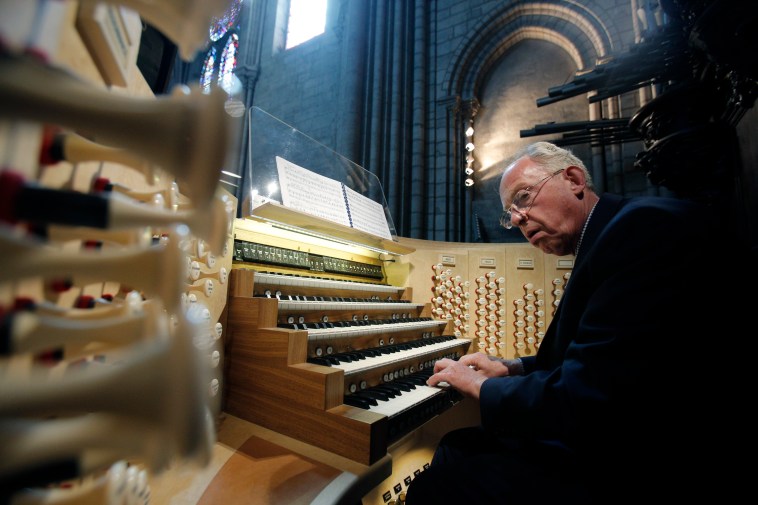PARIS (AP) — From the moment the teenage musician caught sight of the organ in France’s most famous cathedral, he knew where he wanted to play. In the five decades since, Philippe Lefebvre has traveled the world to play what he describes as an “orchestra of one,” but the organ master returns to the loft above Notre Dame and is never disappointed.
Videos By Rare
He has none of the infamy of Notre Dame’s bell-ringer and is invisible to the thousands of visitors Notre Dame receives each day. But Lefebvre said he never misses the direct contact with his audience that so many musicians crave. For the 64-year-old, it is enough to be the caretaker of what he considers an almost otherworldly instrument.
He first saw it when he was 15, as a young piano student.
“I thought that there were many more possibilities than with a piano. Even though I find the piano magnificent, this is just a whole new world,” he said.
A few visitors may notice the biggest pipes above the entrance, but most turn their eyes no higher than the stained glass windows along the sides. Lefebvre, when he plays, is hidden even further — behind the brand new wooden-paneled console that he compares to a cockpit — five cascading keyboards and more than 200 stops.
A century ago, six strong men were needed to pump enough air for the music. Now, there is an air compressor behind the scenes, and the newly rebuilt instrument itself has a touch-screen panel that can note “favorite” stop combinations like a browser bookmarks a Web page.
Despite the advances in organ technology, Lefebvre feels the weight of history in his job. There are deep gashes in the wood carvings of the organ loft — a legacy of revolutionaries from the late 18th century who slashed away the fleur-de-lis symbol of the monarchy. But, Lefebvre said, they refrained from melting down the metal pipes into bullets during the war after heeding pleas from Notre Dame’s organ master, Claude Balbastre, who had adapted to new political realities by composing variations on the Marseillaise anthem.
Notre Dame briefly opened its organ loft on Thursday to show off the new instrument — refurbished for the cathedral’s 850th anniversary this year. Each of the nearly 8,000 pipes — some of which date back to the 18th century — was individually cleaned and returned to its place. The new electronic panel, the five cascading keyboards and more than 200 stops were installed.
Lefebvre began his musical career on piano, but he says “the piano is an industrial product. Each one is basically like the other. Every organ is unique, made for a particular place.”
In cavernous Notre Dame, the organ’s location is unparalleled. When Lefebvre plays the opening of “Piece Heroique” a few tourists turn toward the sound. By the end of the grandiose piece, the wooden floor of the loft is vibrating, Notre Dame’s arched ceiling echoes with the sound and below, flashbulbs flare upwards. A pigeon that had been roosting on one of the horizontal pipes took flight for quieter territory.
“Notre Dame’s organ is particular because it is one of the only organs that has retained the traces of centuries. As the cathedral itself. So at the same time you have tones from before the Revolution, some from the 19th century similar to a symphonic orchestra, and also all the recent inputs of the 20th century. You have three or four authentic centuries of music,” he said. “It resonates in the stones of the cathedral.”
The big organ is played on weekends and for major ceremonies and holidays, the playing shared by three organists who have held the job since 1985.
Because organs employ the sounds of a multitude of instruments, it is usually up to the organist himself to decide the combination of stops he wants for any given piece. That decision can change according to the organ, the space and improvisational whim.
“Since sheet music didn’t exist in the early years of the organ, organists improvised. This tradition continued in Europe, and especially in France,” he said.
Each key, Lefebvre said, is like a letter on a computer keyboard. The stops and pedals, he said, elaborating on the metaphor, are like a font. And he can bring back 5,000 different combinations of stops with the new electronic memory. Things have changed since the keyboard that connected to the pipes by long mechanical arms. But even the most advanced organ, he said, is not built by programmers and engineers alone. “You also must be a musician.”
And organists themselves are untethered to any one instrument. Lefebvre said he has played thousands of organs around the world, gleaning something from each one.
Still, Notre Dame remains his ideal as it was when he was young.
“Here in Notre Dame when you play a tone, it resonates for eight to nine seconds. It is exceptional — the sound spreads across the whole structure and you feel it when you play,” he said. “The sound just comes back to you.”
Follow Lori Hinnant at: https://twitter.com/lhinnant
Copyright 2013 The Associated Press.

